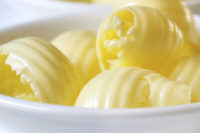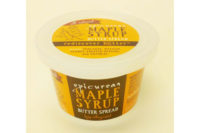Appreciating Butter's Beauty

New food product trends indicate consumers' palates are demanding more flavorful, bold-tasting foods. Macaroni and cheese must be rich and zesty. Ketchups and mustards have tang and bang.
Margarine manufacturers know nothing beats the rich, creamy taste of butter, which is why formulators try to mimic it and marketers claim similarities. Ironically, butter marketers seldom boast their wares and do very little in the way of promotion, except during holidays. In fact, it is questionable if some mainstream butter marketers have ever upgraded their packaging since butter first debuted in quarter sticks more than a century ago.
According to the Private Label Manufacturers Assn., at the supermarket level, butter is a $1.1 billion business, with about 44% sold as private label. On the other hand, the category of margarine/spreads/butter blends is valued at $1.3 billion, with only around 8% sold as private label.
The quick assumption here is that brands provide little value to consumers when it comes to buying butter. That butter is all about price, and private label butter typically costs about a dollar per pound less than branded butter. But a marketer need only reflect on the powerhouse bottled water brand Evian to be reminded that if properly supported with a powerful message, an effective brand can sell a liter of something consumers get free from the faucet for a price higher than a gallon of gasoline.
The good news with butter is consumers can't get it from a faucet, or anyplace other than having it be churned from cows cream. With a little innovation in flavor, packaging, marketing and promotion (never mind the fact that many margarines are loaded with the newest evil -- trans fatty acids), consumers might buy more butter and even, quite possibly, seek out a specific brand because of its reputation and quality.
Here's one butter manufacturer's quest to put butter back in the spotlight it so deserves.

Cream of the crop
"Butter is the perfume of dairy," says Gabrielle Proia, owner Mendon Creamery, Mendon, Mass.Proia has been churning butter for about three years in what can be described as a farmstead operation. She rents space on a 150-herd dairy farm to produce and hand-pack six varieties of butter. On many days, she is the one milking those cows, which means her day starts at around 4:00 a.m., five to seven days a week. The week does not end until about 1,000 lbs of butter are churned and ready for delivery by the distributor Proia contracted about a year-and-a-half ago when it became a bit too much to milk, churn and be in sales.
Butter, which is made exclusively from cows milk, cream or both, with or without salt, contains at least 80% milkfat by weight. It is considered by many as the "cream of the crop" for a variety of reasons.
Most importantly, it's because only the best-tasting milk and cream should go into making butter. "Whatever the milk and cream that goes into butter tastes like, that's what the butter will taste like -- just magnified. Butter is the essence of milk and cream," says Proia. "In fact, I will only buy cream from two area dairy farmers, because only their cream meets my standards."
There are two primary types of butter produced in the United States -- sweet cream and cultured cream -- with sweet cream butter the most common, and also the variety that Proia churns.
"When my husband and children moved to Mendon (a rural, sleeping community about 40 miles southwest of Boston), I became intrigued with the neighboring dairy farm and took a job milking the herd," says Proia, a Carmel, Calif., native. "Keep in mind, I knew nothing about milking cows.
"Soon my creative side took over, and I wanted to do something with that milk," she says. "I embarked on a research trip and visited dairies throughout the New England and New York regions. It did not take long for me to identify that not only was it fairly easy to make butter -- equipment and start-up costs are minimal-but butter was also something really untapped. Most dairies were treating butter as a commodity, with little being done creatively."
Currently Proia churns six varieties/flavors of sweet cream butter: Unsalted and Lightly Salted (using sea salt), Cinnamon Sugar, Lemon Herb, Maple Cream and Roasted Garlic. She hand packs them into 8-oz white cardboard tubs and hand applies decorative labels that indicate flavor and provide manufacturer and ingredient information.
Originally Proia sold the butters to area farm stores and local merchants. With the help of her distributor, Mendon Creamery Butter can be found in specialty, gourmet stores around the country including select Whole Foods Markets and Fox & Obel. The suggested retail price is $3.50-$4.00. "Mendon Creamery Butters are always sold in the dairy section, not the specialty case, as this helps keep the price down," she says. "The specialty case often commands a 100% mark-up and I want all consumers to be able to afford and enjoy these butters, not just the ones with an open checkbook.
"I started with no capital and within three years have become a profitable company," she concludes. "I truly want butter to get the recognition it deserves. I also believe in keeping the price of my products consistent and not too high. I will not pass the high price of butterfat onto my customers. I also believe in paying the farmers what they deserve and won't participate in the market."
Other added-value churners
Land O'Lakes Inc., Arden Hills, Minn., a leading U.S. butter marketer, recently debuted a variety of added-value butter spreads. On the flavored side of things, this past year the company introduced Land O LakesR Creamy Honey Butter and Land O Lakes Roasted Garlic Butter with Olive Oil. In addition to honey and butter, Creamy Honey Butter also contains liquid soybean oil and partially hydrogenated soybean oil. Oil assists in making these products spreadable right out of the refrigerator, which is also the formulation secret behind the company's two more recent entries: Land O Lakes Spreadable Butter with Canola Oil and Land O Lakes Soft Baking Butter with Canola Oil (see page 42).To add value, butter marketers such as Organic Valley, LaFarge, Wis., produce cultured butter, a rich butter made from cultured cream that is very popular in Europe. Cultured, or European-style butters are also higher in fat content, which provides added richness and functionality in bakery products.
Another value-added butter is described as clarified. Clarified butter is a purified, thicker form of butter that's been melted and has had water and milk solids separated from the clarified or clear part. Because the water has been extracted, clarified butter does not burn at high temperatures, and therefore is commonly used as a fat for cooking.
Odell's, Reno, Nev., is introducing its foodservice clarified butter to the retail market so consumers can reap the benefits of cooking with the great taste of butter. The butter is marketed "for cooking, for baking, for flavor." Very soon the company plans to introduce Chef's Butter, which is a line of shelf-stable "seasoned finishing butters" in flavors such as Basil Pesto, Garlic Herb and Steakhouse.
Editor's Note: In addition to the value-added ideas described, this editor would like to see marketers enhance the graphics on their 1-lb boxes that contain four sticks of butter. Imagine a digital image of chewy chocolate chips cookies on the package instead of a cow. Next time mom needs to buy a solid fat ingredient to make cookies, and that image stares at her and the kids in the grocery store, good chance the photo will convince them butter is better-a message consumers need to be reminded of all the time.
Looking for a reprint of this article?
From high-res PDFs to custom plaques, order your copy today!




